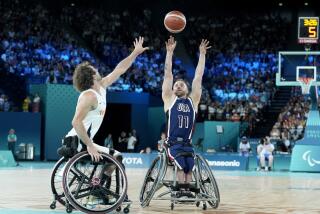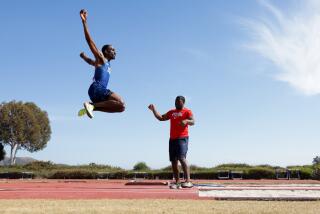An athlete’s mission
Hunched over the handlebars of a stationary bicycle, Sarah Reinertsen vigorously pumps the pedals as a thin layer of sweat coats her back and shoulders. Her coach, evaluating her heart rate, checks the readout on the monitor and gradually increases the bike’s resistance.
In a sports bra and shorts, Reinertsen looks like any other athlete in training, except that her right leg is made of flesh and bone and her left is made of metal and plastic. The heart rate test over, she towels off, unlocks the prosthetic foot from the bike’s pedal, switches to a different artificial leg and walks out of the gym.
Reinertsen, 29, is a world record holder in marathon and half-marathon events for above-the-knee amputees. Currently she is on a mission -- well, many, actually -- this particular one having to do with finishing the Hawaii Ironman, considered the pinnacle of triathlons. In 2004 she was the first female amputee to compete in the race, but she was beset by high winds and bouts of nausea, ultimately slowing her bike course time and disqualifying her for the marathon portion.
She’s determined to try again this October. “At first I thought maybe it was too hefty of a goal,” she says over a bowl of soup at a nearby cafe. “But now I think, I get to do this again. There are triathletes who race their whole life and never get to do Hawaii, and the fact that I have an opportunity to do it again is special.”
The attitude is typical of the vivacious Reinertsen, who, though petite, has a powerful, lean body. An amputee from the age of 7, she found her niche in sports early, over the years becoming an influential role model in the disabled community. Participation in high-profile events has given her the kind of visibility that many physically challenged athletes never get. Her story was among those highlighted in television coverage of the Ironman.
“Everybody has talked about how motivating and inspiring she’s been,” says Blair LaHaye, Ironman’s public relations director. “She’s got a great spirit, and people wanted to follow her journey. Viewers were really pulling for her.”
Reinertsen was born with proximal femoral focal deficiency, a rare birth defect in which the portion of the thighbone closest to the hip is too short or not developed. Growing up on Long Island, she wore a brace until age 7, when her deteriorating leg had to be amputated. She was given a bulky wood composite prosthetic, and her parents insisted that she be treated like any other student -- no adaptive physical education classes, no special concessions. “I credit them a lot with that,” she says. “That was incredibly important.”
Unfortunately, gym teachers didn’t always share that progressive view. The energetic Reinertsen often was left out of games or picked last for teams. Her frustrations eased at age 11, when she attended a track meet for kids with disabilities. She ran the 100-meter dash and won.
Reinertsen ran with a hop-skip gait until she met physical therapist David Balsley, who taught her how to run leg-over-leg and guided her toward better prosthetics. (Today her prosthetic running leg has a C-foot, the design based on the hind foot of a cheetah. The shape allows her to propel forward, and she describes the action as “bouncing on a pogo stick.” The adjustable hydraulic knee is set to allow it to move more freely when running.)
Reinertsen and Balsley trained together three days a week, Balsley teaching her exercises to strengthen her left hip. “He’d put me on the treadmill and make me go as fast as I could,” she recalls. “He really pushed me. There was none of this ‘We’re going to go easy on the disabled girl.’ He always instilled in me that even the crazy things were possible.”
She took to Balsley’s no-limits approach to training. “I think Sarah likes to challenge herself,” he says from his home in Manhattan. “She likes to see what’s in there. Some people never flip the switch. They never go anywhere; they start and they stop. Sarah’s definitely kicked it on.”
Another of Reinertsen’s mentors was Paddy Rossbach, an amputee marathoner from Connecticut who is president and chief executive of the Amputee Coalition of America, a nonprofit advocacy group. “She was tiny, with legs like two sticks of spaghetti,” Rossbach recalls of the 11-year-old Reinertsen. “Sarah was always determined to do something, even with that clunky leg. She was very self-possessed, motivated and disciplined. There’s a certain element in some people who lose a limb or other faculty that makes them want to show they can do everything.”
Athletics gave the young Reinertsen confidence, an outlet for typical teenage angst and a way to deal with the atypical life she had. “I remember looking in the mirror,” she says, “and going, ‘Grrr! I’m going to be tough and strong, and who cares about’ ” the other kids at school?
Sprinting became Reinertsen’s forte, and, at 17 she competed in the Paralympics for disabled athletes in Barcelona. Favored to do well, she tripped out of the starting blocks and ended her hopes for a medal. Following that she enrolled at George Washington University in Washington, D.C., and was somewhat relieved that the school had no track team. It would allow her to forge an identity outside of athletics.
But after a while she missed the competition. So she took up distance running, graduating from 5Ks to 10Ks to long relay races and, finally, to her first marathon, the 1997 New York Marathon, which she finished in a little more than six hours. She moved to Los Angeles in 1998 to get her master’s degree in journalism at USC, and during school alternated running marathons here and in New York. She got a job as a producer and on-air reporter for a company that produced sports-related shows. She left that position in 2003 to take a job with the Challenged Athletes Foundation.
Reinertsen had participated in fundraisers for the Del Mar-based foundation, which provides grants for adaptive sports equipment for physically challenged athletes and sponsors athletes in training and competitions. She managed the grants and started a mentoring program, something with which she had experience.
Meeting a novice athlete at a race or in the prosthetist’s office, Reinertsen would offer running tips or encouragement, a conversation that would sometimes segue into a mentorship.
“It’s what a lot of disabled people need,” she says. “They need to talk to someone when their leg isn’t fitting right or when they have a question about what kind of foot to use.”
Scout Bassett met Reinertsen at a Disney World track meet in 2002; it was Bassett’s first competition. “Sarah looked at me and said, ‘That girl needs some help,’ and she got me started.”
The two have had similar experiences; Bassett is also an above-knee amputee and felt ostracized in team sports despite her desire to participate. Reinertsen, she says, encouraged her to try solo pursuits such as running.
“I feel really different now,” she says from her home in Harbor Springs, Mich. “I feel much more confident, especially physically. I learned from Sarah to look at my disability as one of my greatest gifts. It’s not who you are; it doesn’t define your character. She’s shown me that with this disability you can accomplish great things and change the world if you want to.”
It’s a philosophy that Reinertsen did not come by easily. When asked if she ever tires of being the upbeat role model for amputee athletes, she pauses and says, “Certainly I have bad days. Training for the Boston Marathon last year I had this sore on the bottom of my stump that lasted for two weeks. Day to day I put on my leg and I can do anything.” But when injuries compel her to use crutches instead of a prosthetic, “that’s when I think, ‘I am disabled.’ ”
For a long time, she says, “I didn’t want to be the disabled poster child. But now I don’t see myself as just that. I like to think of myself as more of an advocate and role model pushing for change.”
She strongly encourages amputees to be physically active, believing that staying in shape can improve one’s quality of life.
“You may not want to run a 10K or do a triathlon,” she says, “but to keep up in everyday life you need to be fit. Amputees use more oxygen and energy, so just to get around and keep up with the kids and do the lawn work, you need to be fit.”
Not every fellow amputee she encounters takes to exercise as she has: “Sometimes older people are resigned, perhaps because they’re so set in their ways,” she says. “They say, ‘I can’t do that,’ and that’s something that does frustrate me because I believe there’s a lot of potential there.”
Last November, Reinertsen became marketing manager of Ossur North America, a prosthetic company based in Aliso Viejo (she remains a national spokeswoman for CAF). After last year’s Ironman she slowed down her intense training in favor of regular runs, bike rides and swims. She recently started working with highly regarded triathlon coaches Paul Huddle and Roch Frey at the Multisports training facility in Encinitas and will soon begin serious preparation for the Ironman and a few races before that.
The coaches have some experience working with physically challenged athletes, but Huddle adds, “We’re breaking ground for ourselves, and we’re going to rely on her feedback and suggestions. It’s a new world for us.”
Part of their strategy will be strengthening Reinertsen’s left leg with weight training because above-knee amputees are often much weaker in the affected leg.
“I am very pumped and excited,” Reinertsen says. “I’m also thinking I’ve got 10, 15 hours a week in training sessions in addition to work, and how am I going to do this all again? It’s a big commitment. But this is my passion right now.”


